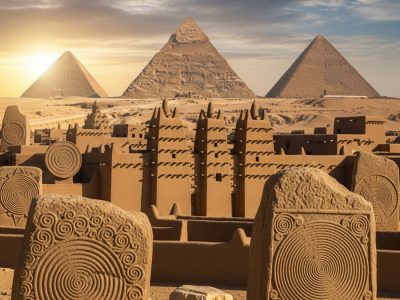Maths and Monuments: Sacred Geometry in African Architecture

Africa’s ancient builders were also mathematicians and more (Imagined by Gemini AI)
Sacred Geometry: Africa’s Hidden Code
Across Africa, ancient builders embedded their monuments with patterns that were far more than decoration; they were mathematical signatures. These forms, known today as sacred geometry, combine science, spirituality, and art. They express the belief that the universe itself is structured on a set of divine proportions, and they appear in monuments from the deserts of Egypt to the rainforests of Nigeria and the sands of Mali.
Sacred geometry uses shapes like circles, triangles, spirals, and polygons to reflect cosmic order. In African architecture, these were not just aesthetic choices; they were blueprints for balance, harmony, and a connection between earth and the heavens.
The Pyramids: Precision in Stone
The Great Pyramid of Giza is one of the most studied examples of sacred geometry in the world and one of Africa’s most enduring symbols. Its base forms a nearly perfect square, each side measuring about 230.4 metres, with less than 0.1% error in symmetry: an astonishing feat for a structure built over 4,500 years ago.
Mathematicians have found the golden ratio (φ ≈ 1.618) embedded in its proportions. The pyramid’s height relative to its base perimeter closely approximates 2π (pi), suggesting that its builders encoded both the circle and the square, a union of heaven (circle) and earth (square) in one monumental design. This geometric mastery wasn’t just technical. In ancient Egyptian cosmology, aligning a building with celestial bodies (as the pyramids are aligned with Orion’s Belt) connected the pharaoh’s soul to the gods. Geometry was, in a very real sense, a spiritual language.
The Ikom Stones: Spirals of Memory
In Ikom, which is in Cross River state in southeastern Nigeria, the Ikom Monoliths stand as silent sentinels of an ancient culture. Carved from basaltic rock many are decorated with spirals, concentric circles, grids, and meanders, geometric forms that echo symbols found in sacred geometry worldwide. The spiral, for example, mirrors the Fibonacci sequence, a mathematical progression that appears in nature from snail shells to galaxies. In sacred geometry, the spiral represents growth, cycles, and spiritual evolution.
The positioning of the stones in circles or aligned clusters may also have served as astronomical markers, much like Stonehenge, mapping seasonal changes and celestial events. Here, mathematics was a cultural compass, guiding both ritual and agricultural life. The actual age of the monoliths is inconclusive, with scholars suggesting they are as early as 200AD or earlier, while others claim they are relatively young, dating around 1900 A.D.
Timbuktu: Geometry in the Desert
The city of Timbuktu in Mali was not only a hub of trade but also a centre of Islamic scholarship during the 14th–16th centuries. Its mosques and madrasas reveal a sophisticated use of geometry in both design and symbolism. Structures like the Djinguereber Mosque and the Sankore Madrasa employ proportions based on square roots, hexagons, and repeating polygons: patterns that reflect the Islamic tradition of geometric design as a form of devotion. Repetition and symmetry were seen as a reflection of divine infinity.
Mathematical precision was also practical: proportions dictated structural stability in the desert climate, while earthen materials demanded exacting angles to prevent erosion. Here, sacred geometry was both an art form and a survival tool. The use of sacred geometry in African architecture shows a profound truth: mathematics and spirituality are not opposites; they are partners. These designs encoded cultural memory, spiritual belief, and scientific knowledge in forms that could endure for centuries.
In an age when architecture is often dominated by speed and cost, sacred geometry offers a reminder that buildings can be more than functional spaces. They can be living symbols connecting people to the cosmos, the land, and each other. The Pyramids, the Ikom Stones, and Timbuktu’s mosques stand as proof that Africa’s ancient builders were not only architects but also mathematicians, astronomers, and philosophers. They understood that geometry could be sacred, a bridge between the seen and the unseen. And in their monuments, they left us a message: the patterns of the universe are worth building into our world.
Recommended: Oklo Nuclear Reactor: Natural Wonder or Ancient Science?
